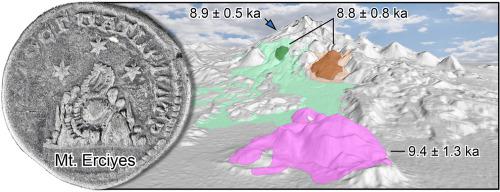Quaternary Geochronology ( IF 1.7 ) Pub Date : 2020-10-11 , DOI: 10.1016/j.quageo.2020.101129 Bjarne Friedrichs , Gokhan Atıcı , Martin Danišík , Esra Yurteri , Axel K. Schmitt

|
Mt. Erciyes (3917 m), the highest stratovolcano in Central Anatolia, Turkey, is considered active based on three recently dated early Holocene dome eruptions that were also correlated with tephras in the Mediterranean and the Black Sea. Despite the demonstrated Holocene activity of Mt. Erciyes, the eruptive chronostratigraphy of these events and their hazard potential for the nearby Kayseri metropolitan area (population ~1.4 million) remain poorly constrained. Here, we apply zircon double-dating (ZDD) based on (U–Th)/He thermochronology and U–Th–Pb crystallization ages, where intra-grain crystallization age differences were used for disequilibrium correction. Individual ZDD ages were refined via sequence modeling to reconstruct the eruption timing of four early Holocene domes peripheral to Mt. Erciyes.
Sequence modeling, which incorporated petrological, volcanological, and stratigraphic constraints, yielded the following eruption ages (uncertainties stated at 1σ): 8.8 ± 0.8 ka for stratigraphically directly superimposed Perikartın and Karagüllü, 8.9 ± 0.5 ka for Dikkartın, and 9.4 ± 1.3 ka for previously undated Yılanlı Dağ, located within the perimeter of Kayseri. A model where all four early Holocene domes are assumed to have erupted simultaneously suggests an age of 8.9 ± 0.4 ka. Earlier eruptive phases of Mt. Erciyes were identified by ZDD at ca. 85–88 ka (fall-out deposits and Çarik Tepe lava) and at ca. 105 ka (xenoliths from two peripheral scoria cones).
Zircon crystallization ages reveal protracted magmatic activity beneath Mt. Erciyes since ca. 800 ka, in agreement with dated volcanic activity, and preceding magmatic phases at ca. 2–3 Ma that included the eruption of the widespread Valibaba Tepe Ignimbrite with a U–Pb zircon age of 2.73 ± 0.02 Ma. A volume estimate for the Quaternary edifice of ~300 km3 translates into an integrated long-term eruptive magma flux of ~0.4 km3/ka for post-collisional Mt. Erciyes, within uncertainty of the Late Pleistocene–Holocene flux estimate of >0.1 km3/ka based on dome volumes and eruption ages. The near-synchronous eruptions of a suite of four evolved domes, in three cases with sizable early explosive venting, calls for a hazard assessment that combines the impact of multiple simultaneous eruptions.
中文翻译:

全新世早期锆石两次定型的序列建模。Erciyes圆顶(安纳托利亚中部)
公吨。埃尔西耶斯(3917 m)是土耳其中部安那托利亚中部最高的平流火山,根据最近发生的三次全新世早期穹顶喷发与地中海和黑海的特非拉斯相关,被认为是活跃的。尽管已证明了山的全新世活动。Erciyes,这些事件的爆发年代地层及其对附近开塞利都会区(人口约140万)的潜在危害仍然受到限制。在这里,我们基于(U–Th)/ He热年代学和U–Th–Pb结晶年龄,应用锆石双日期(ZDD),其中将晶粒内结晶年龄差异用于不平衡校正。通过序列建模完善了各个ZDD的年龄,以重建Mt外围的四个早期全新世穹顶的喷发时间。Erciyes。
结合了岩石学,火山学和地层学限制的层序模拟,产生了以下喷发年龄(不确定性以1σ表示):地层直接叠加的Perikartın和Karagüllü为8.8±0.8 ka,Dikkartın为8.9±0.5 ka,而Dikkartın为9.4±1.3 ka。以前未注明日期的YılanlıDağ,位于开塞利周边。假定所有四个全新世早期穹顶同时爆发的模型表明年龄为8.9±0.4 ka。山的早期喷发阶段。Erciyes在大约 约85–88 ka(沉降矿床和ÇarikTepe熔岩)和约。105 ka(来自两个外围矿渣锥的异岩)。
锆石的结晶年龄揭示了山下长期的岩浆活动。自从大约 800 ka,与已过时的火山活动相一致,并且在大约成岩前期岩浆相。2-3 Ma,其中包括普遍的Valibaba Tepe着火岩的喷发,锆石的U–Pb年龄为2.73±0.02 Ma。第四纪高层的约300 km 3的体积估计转化为碰撞后Mt的约0.4 km 3 / ka的综合长期喷出岩浆通量。Erciyes,晚更新世-全新世通量估计值的不确定性> 0.1 km 3/ ka基于圆顶的数量和喷发的年龄。一组四个已演化圆顶的近乎同步爆发,其中三起具有相当大的早期爆炸泄放,需要进行危险评估,以结合多次同时爆发的影响。











































 京公网安备 11010802027423号
京公网安备 11010802027423号